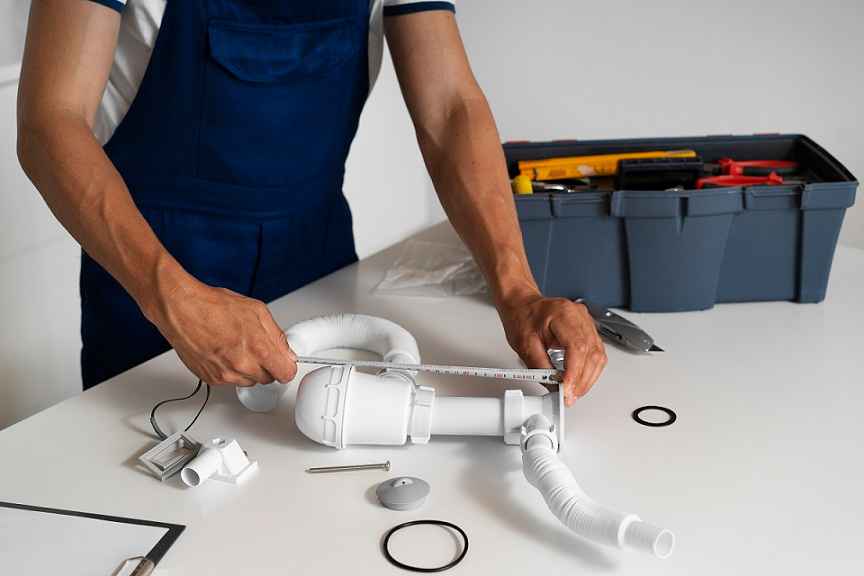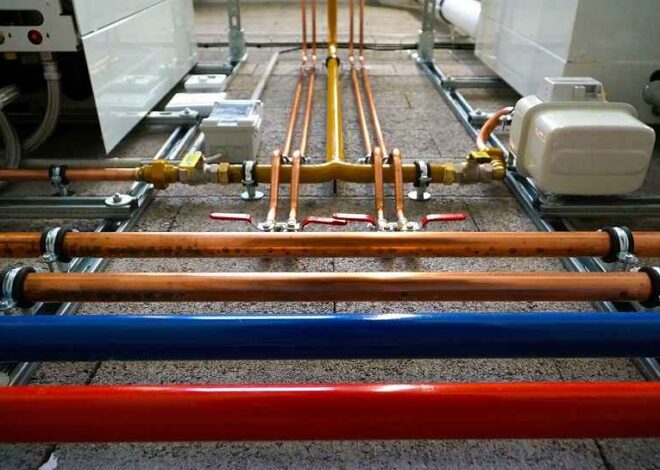
The Ultimate Guide to Plumbing Pipe Materials: Which One Reigns Supreme?
When it comes to plumbing, the materials you choose can make or break your system. With a myriad of options available—each boasting its own set of advantages and drawbacks—deciding on the right piping for your home can feel overwhelming. In “The Ultimate Guide to Plumbing Pipe Materials: Which One Reigns Supreme?”, we’ll cut through the confusion and take you on an informative journey through the most popular types of plumbing pipes. From sturdy copper to versatile PVC, discover which material stands out as the champion for durability, cost-effectiveness, and performance. Whether you’re planning a DIY project or simply want to be better informed about your home’s plumbing, this guide is your go-to resource for making educated choices that will last for years to come! Let’s dive in and uncover which pipe reigns supreme!
Introduction to Plumbing Pipe Materials
When it comes to plumbing, the choice of pipe materials can make a world of difference. Whether you’re renovating an old bathroom or tackling a new construction project, understanding the options available is crucial. Plumbing pipe materials not only affect the efficiency and durability of your system but also impact installation costs and long-term maintenance.
With so many types on the market, how do you know which one reigns supreme? Each material boasts its own unique benefits and drawbacks that can influence everything from water quality to longevity. As we dive into this ultimate guide, you’ll gain insights into various plumbing pipe materials that will empower your decision-making process. Ready to become a savvy homeowner or contractor? Let’s explore!
Common Types of Plumbing Pipes and their Pros and Cons
When it comes to plumbing pipe materials, several options stand out. Each type has its own unique benefits and drawbacks.
Copper pipes are known for their durability and resistance to corrosion. They can last decades but come with a higher price tag. Their installation requires skilled labor, which is another factor to consider.
PVC pipes are lightweight and easy to work with. They’re resistant to rust and chemical damage, making them popular for drainage systems. However, they’re not suitable for hot water applications.
PEX pipes offer flexibility that other materials can’t match. Installation is quick since they bend around corners easily. On the downside, PEX is sensitive to UV light and may require protection in outdoor settings.
Galvanized steel pipes provide strength but tend to corrode over time, leading to potential leaks. They’re heavy and challenging to install compared with modern alternatives.
Cast iron pipes boast excellent soundproofing qualities but can be cumbersome due to their weight and susceptibility to rust when exposed outside.
-
Copper Pipes
Copper pipes are a popular choice in plumbing for many reasons. They have been trusted for decades due to their durability and resistance to corrosion. This makes them ideal for both hot and cold water applications.
One of the standout features of copper is its ability to withstand high temperatures without compromising structural integrity. This means they’re perfect for carrying hot water from your heater throughout your home.
Another advantage is that copper has natural antimicrobial properties. It can help keep your water supply cleaner by reducing bacterial growth, which adds an extra layer of safety.
However, installing copper pipes can be labor-intensive and sometimes more costly than other options. Additionally, they are prone to theft due to their value as scrap metal, posing a security risk in some areas.
Despite these downsides, many homeowners still choose copper because it offers reliability you can’t overlook.
-
PVC Pipes
PVC pipes, or polyvinyl chloride pipes, are a popular choice for various plumbing applications. They are lightweight and easy to handle, making installation a breeze. Their resistance to corrosion is one of their most significant advantages.
These pipes excel in transporting water and drainage systems. Their smooth interior surface minimizes friction loss, promoting efficient flow. PVC is also cost-effective compared to other materials.
However, PVC does have its downsides. It can become brittle over time when exposed to UV light, which may limit outdoor use without proper protection. Additionally, extreme heat can cause deformation.
On the environmental front, while they’re recyclable at certain facilities, the production process of PVC has raised concerns regarding harmful emissions. Homeowners should weigh these factors carefully before opting for this material in their plumbing projects.
-
PEX Pipes
PEX (cross-linked polyethylene) pipes have gained immense popularity in recent years. Their flexibility makes them easy to install, reducing labor time and costs.
One major advantage of PEX is its resistance to corrosion and scale buildup. This ensures that your water quality remains high over time. Additionally, PEX can expand, making it less susceptible to bursting during freezing conditions.
Another perk is the quieter operation compared to metal pipes. You won’t hear loud clanging as water flows through these resilient tubes.
However, homeowners should note that PEX isn’t suitable for outdoor use or areas exposed to UV light without protective covering. It’s also worth considering local building codes, which may limit where PEX can be installed.
Despite these factors, many find that the benefits often outweigh the drawbacks when choosing plumbing pipe materials for their homes.
-
Galvanized Steel Pipes
Galvanized steel pipes are known for their strength and durability. Made from iron or steel, they undergo a galvanization process, which involves coating them with zinc to prevent rusting.
One of the significant benefits of galvanized pipes is their ability to withstand high water pressure. This makes them an excellent choice for both residential and commercial plumbing needs.
However, these pipes come with some drawbacks. Over time, the internal lining can corrode, leading to decreased water flow and potential leaks. Additionally, they can be heavier than other materials like PVC or PEX.
Installation may require special tools due to their weight and rigidity. While they have been popular in the past for water supply lines, newer alternatives often offer better performance and longevity without corrosion issues.
-
Cast Iron Pipes
Cast iron pipes have been a staple in plumbing for decades. Renowned for their durability, they can last over 100 years with proper care. This longevity makes them an attractive option for many homeowners and businesses.
One of the standout features of cast iron is its ability to dampen sound. If you live in a multi-story building or close quarters, this can be a significant advantage. Reduced noise from water flow means more peace and quiet at home.
However, these pipes come with some downsides. They are heavy and require specialized tools for installation, which can lead to higher labor costs. Additionally, while resistant to corrosion initially, they may eventually rust if exposed to moisture consistently.
Many modern plumbing systems now favor lighter materials due to ease of handling and installation time. Still, cast iron remains appreciated where strength and durability are paramount considerations.
Which Material is the Best for Plumbing Pipes?
Choosing the best plumbing pipe material often depends on specific needs and circumstances. Each type has its own strengths that cater to different situations.
Copper pipes are known for their durability and resistance to corrosion. They’re ideal for potable water systems, but their price can be a drawback.
PVC pipes offer affordability and versatility, making them popular for drainage and venting systems. However, they aren’t suitable for hot water applications due to temperature sensitivity.
PEX pipes have gained popularity due to their flexibility and ease of installation. They resist scaling and chlorine damage but may not be compatible with all fittings or outdoor use.
Galvanized steel is strong but prone to rust over time, while cast iron is incredibly durable yet heavy, which complicates installation in some scenarios.
The ultimate choice boils down to factors like budget, application requirements, local codes, and personal preferences.
Factors to Consider When Choosing a Plumbing Pipe Material
Choosing the right plumbing pipe material involves several key factors. First, consider the water pressure in your system. Some materials handle high pressure better than others.
Next, think about the type of plumbing project you are tackling. Different installations may require specific materials for optimal performance.
Durability is another crucial aspect. You want pipes that will last and resist corrosion or damage over time.
Don’t overlook temperature tolerance either; certain materials can withstand extreme temperatures while others cannot.
Also, factor in local building codes and regulations that might dictate which materials are acceptable for use in your area.
Lastly, always keep maintenance needs in mind. Some pipes require more upkeep than others to ensure they function effectively throughout their lifespan.
Maintenance and Lifespan of Different Pipe Materials
Maintenance varies significantly across different plumbing pipe materials. Copper pipes, known for their durability, can last over 50 years with minimal upkeep. However, they require occasional checks for corrosion.
PVC pipes are low-maintenance and resistant to rust or rot. They typically have a lifespan of up to 25 years but should be inspected periodically for cracks or damage from extreme temperatures.
PEX is increasingly popular due to its flexibility and resistance to scale build-up. With proper installation, PEX can last around 40 years without much maintenance needed.
Galvanized steel pipes boast strength but often suffer from rust over time, reducing their lifespan to about 20-50 years depending on the environment. Cast iron pipes offer longevity too but may need regular inspections as they are prone to leaks and deterioration after several decades.
Each material presents unique challenges in maintenance that homeowners must consider carefully.
Cost Comparison of Various Plumbing Pipe Materials
When choosing plumbing pipe materials, cost is a significant factor. Each type varies in price, impacting your overall budget.
Copper pipes tend to be on the higher end of the spectrum due to their durability and longevity. While the initial investment might sting, many homeowners find that copper pays off in the long run.
PVC pipes offer a more affordable alternative. Their lightweight nature makes them easy to handle and install, which can save on labor costs as well.
PEX has gained popularity for its balance between price and performance. It’s generally less expensive than copper but offers flexibility that makes installation simpler.
Galvanized steel pipes are often priced competitively but come with hidden costs related to corrosion issues over time.
Cast iron tends toward the upper range too, mainly because of its weight and strength—attributes that can justify their expense under certain conditions.
Environmental Impact of Different Pipe Materials
The environmental impact of plumbing pipe materials varies significantly. Copper pipes, for instance, are highly durable and recyclable. Their longevity contributes to less waste over time, but the mining process can be detrimental to ecosystems.
PVC pipes pose a different issue. While they are lightweight and resistant to corrosion, their production releases harmful chemicals into the atmosphere. Disposal is also problematic since PVC is not biodegradable.
PEX has gained popularity due to its flexibility and lower energy requirements during installation. However, concerns linger about potential leaching of chemicals over time.
Galvanized steel offers strength but requires significant resources for production and often ends up in landfills when replaced. Cast iron is robust yet heavy; it’s known for durability but can rust if not properly maintained.
When choosing plumbing pipe materials, understanding these impacts helps make more informed decisions that benefit both your home and the planet.
Conclusion: The Verdict on the Best Plumbing Pipe Material
Choosing the right plumbing pipe material is crucial for any construction or renovation project. Each type has its unique strengths and weaknesses, catering to different needs and preferences. Copper pipes offer durability but come with a higher price tag, while PVC pipes are economical yet may not withstand extreme temperatures.
PEX provides flexibility and resistance to corrosion, making it a popular choice among homeowners. Galvanized steel boasts strength but can face rust issues over time. Cast iron is known for its longevity in waste systems but can be heavy and challenging to work with.
Considering factors like environment, maintenance requirements, lifespan, and costs will guide you toward the best option tailored to your circumstances. Whether you’re prioritizing budget constraints or long-term performance impacts how you decide on plumbing pipe materials.
Ultimately, there’s no one-size-fits-all answer; it depends on your specific needs and priorities when choosing plumbing pipes for your home or business.


